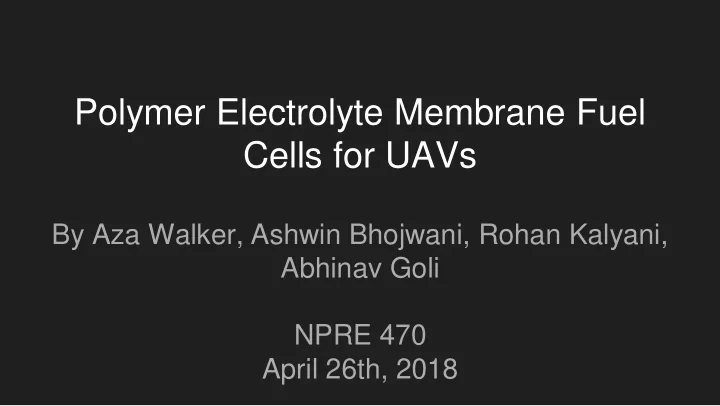

Polymer Electrolyte Membrane Fuel Cells for UAVs By Aza Walker, Ashwin Bhojwani, Rohan Kalyani, Abhinav Goli NPRE 470 April 26th, 2018
Introduction ● UAV - Unmanned Aerial Vehicle ○ No human pilot required; directed by GPS ○ Used in military surveillance applications ● UAV surveillance missions typically are about 40 hours ○ Attains altitude of 60,000 - 65,000 ft ○ Flight speed: 560 km/hr ● Current UAVs use internal combustion engines ○ Fuel source: petro-based (jet fuel) ○ Low efficiency ○ Results in production of greenhouse gases ■ Harmful to environment ● Proposal: Design a UAV using hydrogen and oxygen gas as fuel and oxidizer, respectively, in a PEMFC.
Engineering Requirements for UAV’s ● Long range and lightweight ○ Low weight to high power output → High gravimetric power (W/kg) ● Can function at high altitudes and velocities ● Fuel management system ○ Can compactly store and dispense fuel Thermal management system ● ○ Minimize losses by maintaining fuel cell op. temp. range ● Air management system ○ Filter and pressurize supply air at the correct humidity ■ Air humidity can affect fuel cell performance T.H. Bradley et al. / Journal of Power Sources 171 (2007) 793 – 801
Diagram of PEMFC
Electrochemical Reactions of the fuel cell ● Reaction at Anode 2H 2 4H + + 4e - ● Reaction at Cathode O 2 + 4H + + 4e - 2H 2 O ● Overall Reaction 2H 2 + O 2 2H 2 O
Design and Structure Fuel management Specification Value system Peak Power Output (W) 5000 Number of Cells 320 Cell active area (cm 2 ) 64 Operating temperature (°C) 60 Air management system Hydrogen storage pressure 30 (MPA) Mass (kg) 49.6 Gravimetric Power (W/kg) 100.8 Thermal T.H. Bradley et al. / Journal of Power Sources 171 (2007) 793 – 801 management system
Design and Structure ● Fuel cells would be located in the front of the Fuel Cell Stack UAV just before the wings ● Other parts would be similar to usual UAVs Engine http://www.militaryaerospace.com/articles/2071/05/36-new-mq-9-reaper-uav-attack-drones-ordered.html
Hydrogen Storage in UAV ● Storage methods: ○ Pressurized hydrogen gas ○ Liquid hydrogen ○ Metal Hydride (e.g. Sodium Borohydride)
Hydrogen Storage in UAV cont. Liquid hydrogen is the best storage option; Gives longest runtime
Characteristic features of FCs compared to ● Batteries (Lithium) ○ Converts the fuel and oxidant but does not store any energy. Because air is used as the oxidant and is not stored with the fuel. ○ Runtime is ~5x greater for H 2 (g) and ~10x greater for H 2 (liq) ○ For endurance missions, only fuel storage is necessary while FC system mass constant to increase range. However if batteries are used, more batteries are necessary.
Characteristic features of FCs compared to ● Internal Combustion Engine (ICE) ○ Superior in small-scale engines as they are noisy and polluting, give off high thermal signatures in situations where stealth is necessary ○ Due to higher energy density, ICEs can provide longer endurance ○ Higher altitude flexibility - FCs have positive control of air flow so power reductions can be adapted without oversizing propulsion systems
Benefits of PEMFCs w/ H 2 Storage ● System ○ Higher power efficiency ○ Higher Energy density up to 5x more (gas H2) 50x more ( liq H2) and than ICE- 200 Wh/kg ○ Stability rating 1 on Cooper-Harper scale(1 best - 10 worst) ● Surroundings ○ Friendly to the environment( No greenhouse emissions ) ○ Very low thermal, vibrational, and acoustic signatures
Conclusion ● While time of flight and cost is an issue, with more research and development a fuel cell powered UAVs could be a very viable alternative to currently used methods to power UAVs. ● Fuel cell powered UAVs will be better for the environment and they’ll be more efficient.
References http://citeseerx.ist.psu.edu/viewdoc/download?doi=10.1.1.466.1837&rep=rep1&typ e=pdf http://www.unmannedsystemstechnology.com/wp-content/uploads/2017/02/White- Paper-Fuel-Cell-Energy-Systems-for-UAVs.pdf
Q&A
Recommend
More recommend